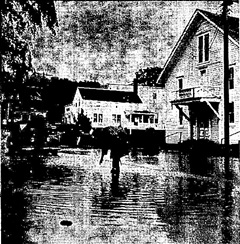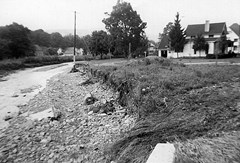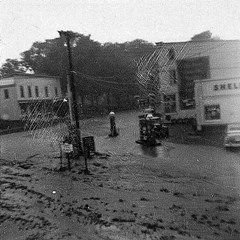
3
The front lawn of George Higgins the Springwater town supervisor after the flooding on the 9th August 1953.
Fed by 5.6 inches of rainfall, flood waters rushed into Springwater last Sunday afternoon, cutting off roads, water, telephone and electric service. Main Routes 15 adn 15A were impassable from 2 p.m. until about midnight because of mud, rocks and the onrushing water, up to three feet deep.
This was a quick sequel to the storm of the preceding day, when a late afternoon gale, accompanied by heavy rain, blew over 38 of the 41 tents at the Ontario County fair in Canandaigua, toppled the ferris wheel, and did other widespread damage on the fair grounds, including serious injury to a small child.
At Springwater last Sunday Livingston County sheriff’s deputies, civil defense, and state troopers rerouted northbound traffic onto Route 63 into Dansville. South bound traffic was rerouted at Lakeville and Hemlock. No public traffic passed through Springwater until Monday night. At present the roads are only temporarily cleared.
Damage is estimated at about $500,000. Every house in the village had a flooded cellar.
The village was without drinking water supply as the reservoir was filled with rocks and silt. Drinking water was brought in a 2,000 gallon truck from Canandaigua, and at present from Rochester. George Higgins, town supervisor, says they can’t yet tell when the reservoir will be back in operation.

4
Deputy Sheriff George Burns measures water depth in front of the Town Hall.
The flood condition, ranging from half a mile south to a mile north of the four corners, brought a general alarm of the Livingston County Civil Defense organization. Fire companies from Avon, East Avon, Mt. Morris, Dansville, Caledonia, Conesus, Lakeville, Lima also responded to pump out basements and clear the roads. Portable pumps were in demand. Crews worked all night, aided by state department of public works men and machinery. In charge of the Livingston County Civil Defense activity was the director, Alvin Hayes of Lima. Two Red Cross canteens, from Lakeville and Wayland, were at the scene to serve lunches and coffee. Trucks and portable pumps were brought from all over the county.
The torrent rushing down East Avenue, the hardest hit area, ripped up the blacktop pavement for a quarter of a mile and left gullies eight feet deep. Four small bridges were badly weakened by the flood. Lawns were covered so deeply with mud and rocks that no green was left showing. Mud and debris piled four feet high in places on the north side of the village. Fortunately, no one was injured.
The Springwater school and the Post Office were badly damaged. Many families moved their belongings to the second floors of houses.
The worst of the flood waters, which had rushed down both slopes of the valley to team with the rising water of Springwater Creek, subsided within a few hours but the damage and debris remained. Sixty-five state department of public works employees and nearly 200 volunteer firemen began the heaviest of the clean-up work.

5
Ethel Perry and George Burns standing at the four corners intersection in Springwater NY.
Nearly the entire population is now busy restoring homes, farms, yards and roads. Rocks of all sizes are strewn everywhere. One house had a cellar wall pushed in. Rubbish was four feet deep in front of the former Clarke Hardware at the four corners. No property owner escaped damage.
George Higgins, a gladiolus grower as well as town supervisor, found two to three feet of rocks and silt on his one and one-half acres of glads. He estimates that in the cleaning up of his property, 100 loads of refuse will be removed. Landscaped lawns such as those of Ethel Perry, a Rochester florist, were ruined by rocks the size of a man’s head, stumps, and sludge. Water dug a 20-foot gully next to the summer home of Harry Stevenson, president of the Rochester Folding Box Company.
Farmers and property owners must now use scrapers and trucks to draw away the hundreds of loads of rocks.
The Charles Cannon Company, makers of electrical equipment, had six inches of mud and gravel covering the floor. They started cleaning operations Tuesday.
Frank Neirocker, state highway superintendent, says it will take at least three weeks to get the roads back in shape. All four bridges also need extensive repair. Tons of soil were washed out by the deluge. Mr. Higgins estimates that it will take two weeks to clean out the reservoir.
Two federal engineers have taken preliminary surveys for a possible flood control project.
|





